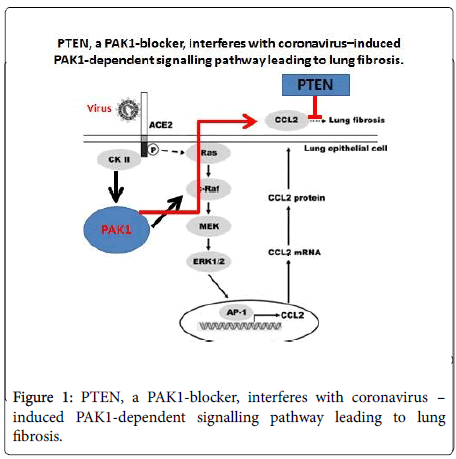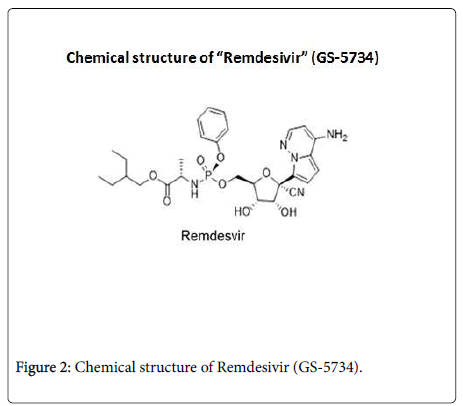Tackling the Coronaviral Infection: Blocking either the “Pathogenic” Kinase PAK1 or RNA-dependent RNA Polymerase (RdRP)
Received: 05-Mar-2020 / Accepted Date: 15-Mar-2020 / Published Date: 22-Mar-2020 DOI: 10.4172/2332-0877.1000418
Abstract
The following are two major scientific evidences for PAK1-dependency of coronaviral infection: (i) A tumor suppressor phosphatase called PTEN, which inactivates PAK1, suppresses the coronavirus-induced CCL2- dependent fibrosis of lungs, and (ii) CCL2 expression depends on coronaviral receptor called ACE2 (angiotensin converting enzyme 2) –CK2/RAS-PAK1-RAF-AP1 signaling pathway. Accordingly, in principle, the following several PAK1-blockers readily available in the market could be potentially useful for the treatment of coronaviral infection: a bee product called propolis, Melatonin from pineal glands, Ivermectin, Triptolide from thunder god vine (a Chinese traditional medicine), and an old pain-killer called Ketorolac. Alternatively, since coronavirus, an RNA virus, requires RNA-dependent RNA polymerase (RdRP) for its replication, a series of its synthetic inhibitors such as Remdesivir would also be useful for tackling this pandemic virus.
Keywords: PAK1 (RAC/CDC42-activated kinase 1); coronavirus (COVID-19); RNA-dependent RNA polymerase (RdRP); Propolis; Ivermectin; Ketorolac
Commentary
One of the recent letters on potential coronavirus therapeutics from Chinese Academy of Sciences at Wuhan to Nature drew my attention. https://www.nature.com/articles/s41422-020-0282-0/
Among the several chemical drugs that they tested against coronaviral infection in cell culture, an old malaria drug called Chloroquine (CQ) and Remdesivir that inhibits RNA-dependent RNA polymerase (RdRP) appear to be the most potent with IC50 around 1 micro M. Unfortunately, however, mainly due to its side effects and drug-resistance, CQ is no longer used for malaria therapy at least in US, Europe and Japan. However, a few other new anti-malaria chemicals such as Arteminisin (AM), which was developed by Youyou Tu in China, a 2015 Nobel laureate and Hydroxylchloroquine (HQ), are in the market for malaria therapy.
Very interestingly, it is well known that both malaria and viral infection in general need the major “pathogenic” kinase (PAK1) in hosts, and all these anti-malaria drugs indeed block PAK1 [1]. I have been working on both PAK1 and anti-PAK1 chemicals for more than 25 years, since the first RAC/CDC42-activated kinase (PAK1) was cloned from mammals in 1994 [2]. https:// www.somatopublications.com/pathogenic-roles-of-pak1-includingoncogenesis- and-ageing.pdf
The following are two major scientific evidences for PAK1- dependency of coronaviral infection: (i) Very recently a team at Colorado University found that a tumor suppressor phosphatase called PTEN, which inactivates PAK1, suppresses the coronavirus-induced CCL2-dependent fibrosis of lungs [3], and (ii) a decade ago a team in Taipei found that CCL2 expression depends on coronaviral receptor called ACE2 (angiotensin converting enzyme 2) –CK2/RAS-PAK1- RAF-AP1 signalling pathway [4] (Figure 1).
In addition to the above anti-malaria drugs, there are several natural or synthetic PAK1-blockers which are readily available in the market: a bee product called propolis, Melatonin from pineal glands, Ivermectin, Triptolide from thunder god vine (a Chinese traditional medicine), an old pain-killer called Ketorolac and so on [5]. In addition, these PAK1- blockers stimulate antiviral immune systems (Ab production) in hosts which are normally suppressed by PAK1 [6] Thus, they would be potentially better than its vaccine alone. I hope the WHO, NIH and other medical officials take this outsider’s wisdom for a tip to tackle or ease the current pandemic corona-virus outbreaks, before its specific vaccine becomes available in the end.
Alternatively, since a group at Alberta University in Canada also confirmed that an ATP analog called Remdesivir or GS-5734 (Figure 2) which selectively inhibits RNA-dependent RNA polymerase (RdRP) derived from this RNA virus is also effective to suppress its replication [7], NIH has recently started the clinical trials of Remdesivir for COVID-19 patients. GS-5734 was originally developed for the potential treatment of Ebola virus in 2019 by Gilead Sciences in California [7].
References
- Maruta H (2014) Herbal therapeutics that block the oncogenic kinase PAK1: a practical approach towards PAK1-dependent diseases and longevity. Phytother Res 28: 656-672.
- Manser E, Leung T, Salihuddin H, Zhao ZS, Lim L (1994) A brain serine/threonine protein kinase activated by Cdc42 and Rac1 (PAK) Nature 367: 40-46.
- Lu S, Strand KA, Mutryn MF, (2020) PTEN (Phosphatase and Tensin Homolog) Protects Against Ang II (Angiotensin II)-Induced Pathological Vascular Fibrosis and Remodeling-Brief Report. Arterioscler Thromb Vasc Biol 40: 394-403.
- Chen IY, Chang SC, Wu HY, et al. (2010) Up regulation of the chemokine (C-C motif) ligand 2 (CCL2) via a severe acute respiratory syndrome coronavirus spike-ACE2 signaling pathway. J Virol 84: 7703-7712.
- Maruta H, Ahn MR (2017) From bench (laboratory) to bed (hospital/home): How to explore effective natural and synthetic PAK1-blockers/Longevity-promoters for cancer therapy. Eur J Med Chem 142: 229-243.
- Huynh N, Wang K, Yim M, et al. (2017) Depletion of p21-activated kinase 1 (PAK1) up-regulates the immune system of APC∆14/+ mice and inhibits intestinal tumorigenesis. BMC Cancer 17: 431.
- Gordon CJ, Tchesnokov EP, Feng JY, et al. (2020) The antiviral compound remdesivir potently inhibits RNA-dependent RNA polymerase from Middle East respiratory syndrome coronavirus. J Biol Chem. pii: jbc.AC120.013056.
Citation: Maruta H (2020) Tackling the Coronaviral Infection: Blocking either the “Pathogenic” Kinase PAK1 or RNA-dependent RNA Polymerase (RdRP). J Infect Dis Ther 8: 418. DOI: 10.4172/2332-0877.1000418
Copyright: © 2020 Maruta H. This is an open-access article distributed under the terms of the Creative Commons Attribution License, which permits unrestricted use, distribution, and reproduction in any medium, provided the original author and source are credited.
Share This Article
Recommended Journals
Open Access Journals
Article Tools
Article Usage
- Total views: 1674
- [From(publication date): 0-2020 - Nov 21, 2024]
- Breakdown by view type
- HTML page views: 1111
- PDF downloads: 563


